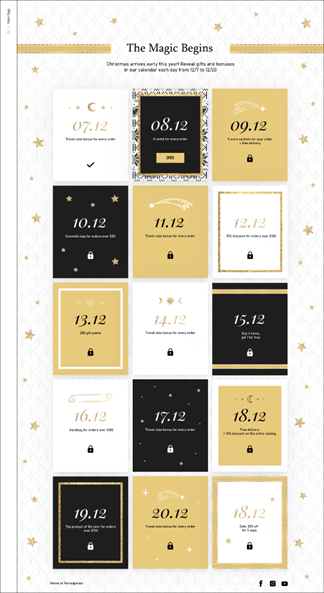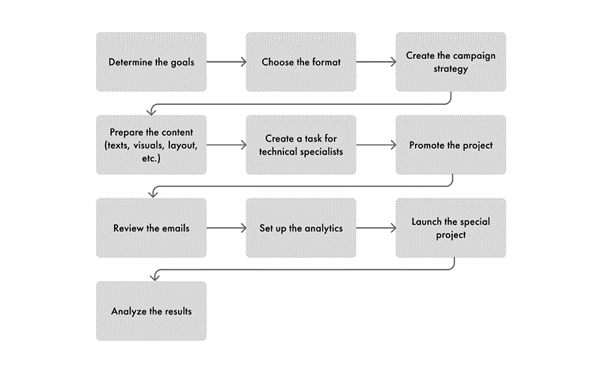My Go-to Solution to Increase Revenue During the Holiday Rush
Soon comes the busy holiday season lots of marketers and companies anticipate and fear at the same time. Want to stand out and make the most of it? Here's the solution that we've been using for the last few years: launch a special project that goes beyond the usual email format and draws more attention.
In this article, I'll discuss the main types of special projects and who can make the most of them. I'll also share what problems my team faced during the development so you can rely on our experience to avoid these troubles.
The Benefits of Special Projects
An effective special project provides a significant boost to a number of marketing and business indicators. In particular, it helps to:
- increase the revenue and AOV
- sell the remaining goods in stock
- boost traffic with viral campaigns
- reach marketing KPIs
- collect the data about your subscribers for future campaigns
For example, a couple of years ago we designed an advent calendar for a popular haircare brand. In short, the campaign went like this:
1. First, we invited the subscribers to enter their email addresses and participate in the Christmas event: for 14 days in a row, they would unlock 1 present or bonus at a time.
Here’s what the calendar email looked like.

2. Each day we sent reminders about current prizes and the number of days left. Since these emails had the same general layout, we used an email builder to make the process faster. This way, we only had to change email copy and images, which saved us a lot of time (we used Blocks, but you can use any other builder of your choice).
In the end, the campaign yielded an impressive 500% ROI. That’s just a single example of how effective a special project can be for a business.
2 Types of Special Projects
Special projects can be divided into 2 types based on the time and budget required for their development and launch:
- Faster and Cheaper (perfect for small companies with tight budgets)
- Complex and Expensive (offers larger outreach and works even for a cold audience)
Faster and Cheaper
Budget: $1500 to $3000
Time required: 2 to 3 weeks
Examples:
1. Quiz or poll. The subscriber answers several questions to receive a prize. For example, beauty brands may ask questions about skincare routines and offer discounts for correct answers.
2. Triggered sequence with simple gamification techniques. Each email contains a new piece of entertainment for the subscriber (for instance, small puzzles or hidden parts of a promo code).
3. Randomizer. Interactive game mechanics that generate random results with a single click (for example, humorous fortune telling).
Advantages:
- Simple projects are fast to develop, even if you didn’t plan these marketing activities in advance.
- You can reach the KPI even with a smaller marketing budget.
- It’s a cost-effective way to test out the audience’s reaction to a creative campaign (especially useful if you’ve never launched special projects before).
More Complex and Expensive
Budget: $3000 to $10,000 (might be more expensive depending on the project complexity)
Time required: 1 to 1.5 months
Examples:
1. Advent calendar. Here, each day marks a special event: prize draw, gifts or promo codes giveaway, etc.
2. Quest. An interactive story where the players have multiple choices that affect the plot and outcome. You may design a traditional quest or have the subscriber play from their own perspective (not as a ready-made character) and answer questions about themselves. This allows you to collect data for personalized campaigns in the future.
3. Mini-games. Emails with simple game mechanics (for instance, Tetris-like or 3-in-a-row). You may design game elements to match the campaign theme: if it’s Christmas, for example, make them look like present boxes.
Advantages:
- A unique and highly creative project has the potential to go viral and attract new customers.
- You can work with cold audiences and introduce your product to them.
- This special project type allows you to bring almost any plot or visual idea to life.
When to Plan a Special Project
While a simple special project can be launched in 2 to 3 weeks, it’s better to begin preparations at least 6 to 12 months beforehand, regardless of project complexity. The practice shows that preliminary non-production operations take the most time. These include:
- activities coordination with management
- budgeting and selection of contractors
- documents drawing up and signing
The best option is to plan a special project in advance and start working on it 1 to 1.5 months before the launch. The exact time frame depends on the number of details, such as the overall idea, campaign budget, marketing strategy, and more.
Launching a Special Project: Step-by-Step Guide
Here are 10 detailed steps that will help you launch a special project even if you’ve never done this before.

1. Determine the goals. For example, “increase sales in the product category by 15%” or “sell out the remaining goods from the stock”. Collect and review the data from previous campaigns to draw up the KPI and forecast the outcome. If this is your first campaign of such type, analyze case studies from other brands in your industry.
2. Choose the format. Hold a brainstorming session to determine several key ideas. Go through their strengths and weaknesses to choose the best one and put it to work. To make things easier, refer to the “2 Types of Special Projects”, select the suitable option, and adapt it for your brand.
3. Create the campaign strategy. Briefly describe the user journey: from the moment they learn about the special project to making a purchase. You need this to correctly set up the special project roadmap.
4. Prepare the content (texts, visuals, layout, etc.). Now it’s time to get the content of your project ready. Make the process time-efficient by organizing a simultaneous workflow for several team members. For example, before writing the email text, the copywriter prepares the structure and estimates the text volume so that the designer can start working on the layout.
5. Create a task for technical specialists. While copywriters and designers are preparing the content, the manager should create a task for technical specialists on the integration of your special project with CDP and ESP. It’s vital if you want to collect user data correctly.
6. Promote the project. Your special project might be perfect, but it needs proper promotions to achieve the goals. Announce your special project through emails, social media, website, and other means. If possible, make use of external channels, such as advertisements on third-party resources or partnership integrations.
For a wider outreach (and to engage your audience in advance), we recommend to begin promoting your special project 2 to 3 weeks before the launch.
7. Review the emails. Check your special project for mistakes and errors. Ideally, let each specialist review their own professional area (i.e. designers check visuals, copywriters proofread texts, etc.).
8. Set up the analytics. Set up project goals and their indicators in your analytics system. The evaluation of business metrics will help you determine the benefits your project brings.
9. Launch the special project. Your special project is fully prepared and ready to hit the inboxes. All that’s left is to launch the campaign.
10. Analyze the results. After the special project ends, collect the data, compare it with the forecasts, and formulate hypotheses that will help you launch future projects more effectively.
What Might Go Wrong (and How to Fix It)
My team has significant experience in developing and launching special projects. We faced various obstacles in the process and came up with solutions to overcome them. Now, I’m glad to share our experience with you.
Here’s what might go wrong during the special project development and ways to fix these problems.
Failure to Meet the Deadlines
There are several reasons why this might happen:
1. The initial idea goes out of proportion. For example, a simple quiz gets enhanced with a second storyline, more prizes, and animations instead of static images. As a result, the development time increases. To avoid this, make a clear plan and describe each stage step by step.
2. Extra tasks aren’t taken into account. These may include, for instance, mobile version development or project adaptation for visually impaired recipients. You can prevent this situation by creating a complete list of project requirements at the early stage of development.
3. Technical challenges emerge. For example, it turns out that an additional third-party tool is required to bring a creative idea to life. The solution: consult with technical specialists at the stage of coordinating the special project idea and ask them what can or can’t be implemented.
Work on the Special Project Has Turned Into Chaos
The time is running out yet the email design hasn’t been approved yet. Or the template is ready but suddenly you need to change the text or visuals.
To avoid this, hold the initial meeting with the team, discuss the responsibilities of each participant, and determine the deadlines for every stage of work. For convenience, create a chart and write down responsibilities and deadlines for each team member.
Gifts or Promo Codes Have Run Out
Prevent this by preparing backup gifts and discounts for goods that are always in stock. For example, the subscriber receives a decorative candle for quiz participation. Don’t indicate the exact model or type of candle: this way, you’ll be able to replace the out-of-stock models with similar ones.
If You’re Worried that Special Project Won’t Pay Off
Create a small-scale test launch! Check your audience’s reaction through a simple project intended for a small segment of your user base. After that, analyze its performance and, in case of success, use it for creating a bigger special project.
For example, imagine that you’re running a pet shop and want to launch a quiz email campaign. First, create a quiz intended only for cat owners. If it performs well, add more storylines (for those who keep dogs, birds, hamsters, or other pets) and increase the number of questions and prizes.
I’d also like to note that many special projects are flexible: they can be used multiple times with different content but the same overall structure. If you make a quiz, change its text and design (keeping the game mechanics and technical settings intact) and put it to work. This way, the production costs will be lower yet the outreach and revenue forecasts will stay the same.
 Photo by Aaron Burden on Unsplash
Photo by Aaron Burden on Unsplash

 How to resolve AdBlock issue?
How to resolve AdBlock issue? 
 Ivan Ilin,
Ivan Ilin,